 Paizo Publishing has made a name for themselves in gaming over the past few years with their release of the Pathfinder Roleplaying Game. This DnD alternative has been very well received since its launch and has since become Paizo’s flagship line. Other than a few quiet titles here and there (Stonehenge, Kill Doctor Lucky), Paizo has mostly stayed out of the board and card game arena.
Paizo Publishing has made a name for themselves in gaming over the past few years with their release of the Pathfinder Roleplaying Game. This DnD alternative has been very well received since its launch and has since become Paizo’s flagship line. Other than a few quiet titles here and there (Stonehenge, Kill Doctor Lucky), Paizo has mostly stayed out of the board and card game arena.
All that has changed though with the new Pathfinder Adventure Card Game that was released at Gen Con 2013. It appears that the goal of the Pathfinder Card Game was to take the familiar parts of the Pathfinder RPG and make it into an accessible, tabletop card game. Did they succeed? Lets find out!
The Pathfinder Adventure Card Game is a cooperative, deck-building and battle-driven card game for 1-4 players that plays in about 60-90 minutes. The Pathfinder Card Game plays best with four players.
Game Overview:
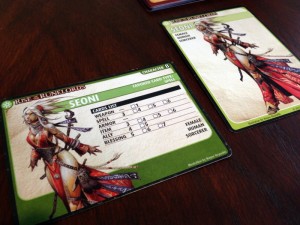
Each player starts the game with a character from the Pathfinder universe. Most of the familiar RPG classes will be here: fighter, cleric, rogue, wizard, etc. Once players have their character deck setup, they must work together to try and defeat the main villain in their chosen scenario. This is accomplished by fighting their way though the different location decks until the villain is found an all avenues of escape for him are gone. If the players can accomplish that before they either all die or run out of time, they’ll win the scenario and collect a nice reward. These rewards are usually in the form of new abilities for their characters or new cards for their deck.
Components:
I am all over the board with the components with the Pathfinder Card Game. There are things I love and things I hate. The box itself is quite large and clearly meant to hold many of the forthcoming expansions. Great job by Paizo thinking ahead. However, the insert tray was crafted in a such a way that it won’t hold sleeved cards. As many gamers sleeve their games, this was a curious decision on Paizo’s part. The other issue I have with the insert is that there is no way to store your game vertically. In Dominion, the rulebook and cover neatly hold all the cards in the tray no matter how you hold your game. In Pathfinder, you have to hold your game box like a birthday cake or all the cards will fall out. As someone who stores all of their games sideways in a “game library,” this is a bit frustrating.
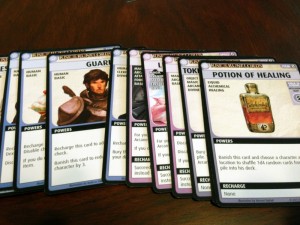
Moving on, the artwork is fantastic in some areas and just okay in others. As the artwork is one of the most important part of a card game, I was a little surprised on the consistency. The player character artwork looks fantastic, I’m a big fan of Wayne Reynolds artwork, and I’m guessing has been borrowed from the Pathfinder RPG books (although I don’t play it, so I can’t confirm that). Many of the other artwork though is somewhat inconsistent and varies from a solitary image on a white background to a full boxed scene. I’m not sure why they didn’t go with the more full box artwork as used in many card games, but there you have it.
Finally, I need to talk about the rule book. There are some things I really like about it, such as the tips and strategy call-outs. I also like the suggested starting decks for each of the characters. That helps get things up and running quickly. However, the rules themselves can be a bit of a headache. This book really, really could have used an index. Somethings are a bit confusing while others are just hard to find. The Pathfinder Card Game in itself isn’t very hard to play, but trying to learn it from the rulebook can be a bit of a chore. The book could have used more rule call-outs or highlights of import things. It took me at least one and a half games of constantly referencing the rulebook to really get a solid understanding on how to play. I was curious if others had as many issues as I did and it appears so. The rules forum on BGG has over 700 threads posted on rules questions for Pathfinder. For a game that’s only been out for three months, that’s many confused people. The game designer, Mike Selinker, has even addressed this issue on Paizo’s forums. It’s really a shame that so many people are having issues learning the game as the Pathfinder Card Game really isn’t that hard to play. If you can find someone to teach it to you, definitely go that route.
How To Play:
OK, that was more time spent on the components than I had planned. It’s time to dive into the nuts and bolts.
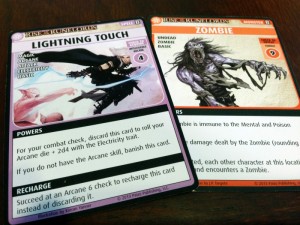
Each player starts the game with a different character. A player must first create his character deck by putting a specific amount of each of the different types of cards in it. Each character will have more of some cards and less of others depending on his class. Players can either choose any cards they want (as long as they are labeled basic), or to make things easier, Paizo has listed out recommended starting decks for each character. I usually go with these and haven’t had any issues.
Once you create your character deck it’s time to setup the scenario. Depending on how many players you have, you construct a number of location decks according to the scenario guide. Each location deck is setup with a number of random cards from various decks (monsters, items, traps, etc.). Once done, you’re ready to start. Play begins with the first player and proceeds clockwise until the game ends.
A player’s turn is completed in five parts. Note: All steps except 1 and 5 are optional:
1. Advance the Blessing Deck. This 30 card deck acts as a game timer. Each turn, the player flips the top card of this deck. If this deck ever runs out, the players lose.
2. Give a card to another player. If a player wants to, they can pass a card to another player at the same location.
3. Move to another location.
4. Explore. A player flips the top card of their location deck and encounters it. More on that later.
5. Reset your hand. Players draw up to their hand limit. If a player ever needs to draw a card and can’t, they die. After that, their turn is over and the next player goes.
Encounters are where the meat of the Pathfinder Card Game happens. When a player explores a location, they flip the top card of the location deck over. Usually it’s either a monster or some kind of boon for the player (items, weapons, blessings, etc.).
An encounter happens in six steps:
1. Determine the skill you’re using. Most combat is done with the strength or melee skill. Other checks will test one of your six attributes or character skills if they have it.
2. Determine the difficulty: A check might have a different difficulty based on which skill or ability score is being used. This is represented in a number the player has to roll to succeed.
3. Play cards. Players can now play cards to add dice or bonuses to their check. Only one card of each type can be played.
4. Make the roll. Collect all the dice you need and give it your best shot.
5. Take damage. If you don’t hit your target number and you are fighting a monster, you take damage equal to the difference. A player must discard a card for each point of damage.
6. Resolve the check. If you succeed in your roll, you either acquire the boon (putting it into your hand) or banish the monster back to the game box. If you fail, the boon goes back to the game box or the monster damages you.
That’s the basics of handling an encounter check. Your main goal with encounters is to find the villain and kill him. If you find one of his henchmen instead, you can try and close out your location if you defeat him. This is good because it stops the villain from escaping there if you find him in a different location. You win until you defeat the villain when he has nowhere else to escape to.
The game ends when the players have found and defeated the villain or they are all dead. The game will also end after 30 turns when the blessing deck runs out.

Game Experience:
The Pathfinder Adventure Card Game is a curious game. It was not at all what I was expecting, and that’s both good and bad I guess. First off, I should address the Role Playing Game (RPG) factor. I’ve been an RPG player since my childhood (I’ve played every edition of DnD) and the Pathfinder Card Game is not an RPG and won’t substitute for one. It absolutely shares some similarities with the RPG of the same name, but anyone who thinks this game will substitute for a traditional tabletop RPG is fooling themselves. To be honest, I’m skeptical that this could ever happen in a card or board game. If you want to play an RPG, pick up one of the zillion or so different ones out there and go with that.
With that out of the way, lets get into what the Pathfinder Adventure Card Game is. However, that’s also where I get a little stuck. The Pathfinder Card Game is definitely a fresh take on the deck building genre. It’s new, it’s different, and it can be a great deal of fun. That is as long as you play this game how it’s meant to be played: as a campaign.
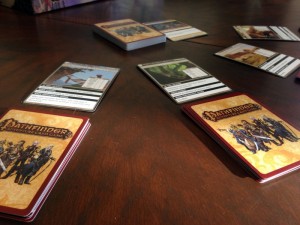
If you are looking for a game to play every now and then with different groups of people then keep on looking. The Pathfinder Card Game is not the game for you. The game play itself isn’t anything remarkable. Draw a card, maybe play a card and roll a die. Honestly, if it wasn’t for the campaign system, this game would be just another blip on the deck-building radar. I’d probably give it a 6 out of 10 on our rating scale. The game play has its moments, but it’s not something that’s going to suck you back in again and again. In an odd sort of way, the game play takes a back seat to what happens outside the game. And that’s OK.
If playing this game as a campaign intrigues you, then you are in for a treat. It took me a while to put my finger on what it was that kept drawing me back to the Pathfinder Card Game, but I finally figured it out. It’s the donkey with the carrot. It’s the formula that every successful MMO has used. It’s the reason why a WoW player spends two hours grinding murloc ears even thought it’s absolutely no fun at all. It’s what drives many RPG players. Leveling your character up. That is the draw of the Pathfinder Card Game.
The Pathfinder Adventure Card Game, in my opinion, is 100% meant to be played as an ongoing campaign. You build up your character over a series of many different games and watch him/her grow in power and abilities. That’s where the fun in the Pathfinder Card Game game lies. It’s building up your character from an insignificant nothing into a force to be reckoned with.
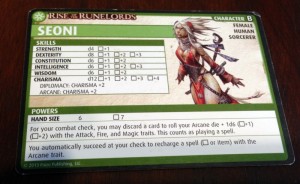
When you start the game, your character is kind of a weenie. The game teases you with his/her future power by showing you many check boxes that you can advance your character with. New abilities, more cards, and combat bonuses. You want them all. And you will keep playing over and over to get them. That’s the draw of the Pathfinder Card Game. If you have ever played a game where you’ve leveled up a character then you know what I’m talking about. That oh-so-satisfying “Ding!” sound when you hit a new level and get to choose a new power. There is always that next goal that’s just out of reach. You are constantly going to want to put this game on the table again to claim that next reward.
Which brings us to the replay value of the Pathfinder Card Game. Paizo has already stated that they are planning on releasing more adventure packs every two months or so. With the rules of the base set, you can play each adventure only once to get the listed bonus. That means, once you’ve run thought all the adventurers in the base game, you have to buy more adventure packs to keep playing (or start all over with a new character). As each adventure pack retails at $20, that’s a pretty sizable investment to play this game over the course of a year. For some people that won’t be an issue, but for the more budget-conscious gamer, that could be a barrier to further enjoyment of the game.
One last thing about the Pathfinder Card Game is how it scales. The game actually works really well as a solo game. You can either play with one character or you can run two. I’ve actually had more fun running two as they can work together to defeat the villian. The game is simple enough once you get a feel for it that playing two characters isn’t very cumbersome. While solo works great, the game is way better with more people. With other players, you can start working together and formulating plans. Many of the characters also have powers that work better with other players (whether they make sense thematically or not – *cough* ranger *cough*), but the real treat is being able to trade cards with other players. With more people, you are exploring more and finding more boons. A solo player might never encounter that really great spell, but with three other people making their way through the location decks, you have much better chance. And really, that’s what the heart of this game is all about. Building up your character and their decks, which at the end of the day, is a ton of fun!
Final Thoughts:
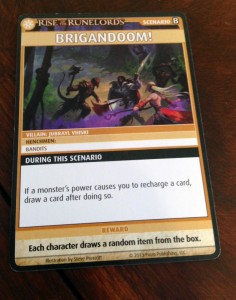
So there you have it. The Pathfinder Card Game takes one of the best parts of RPGs and MMOs and makes a game out of it. Leveling up your character is that addictive drug that’s going to keep you coming back to the table again and again.
There are many gamers out there who probably have numerous games in their collection. If you are one of those and like to rotate what games you play, only playing the same one a couple of times a year, then the Pathfinder Card Game isn’t for you. But if you’re the type of player that loves playing their favorite games over and over, then this will be right up your alley.
Once you get past the rather rough rulebook and some of the fiddly rules, the game play is actually fairly easy. After your first game or so, you’ll have no issue making your way through the location decks without having to constantly reference the rulebook. There is fun to be had with the Pathfinder Card Game, just know what you are in for when you sit down to play. While it might not be a true replacement for a traditional tabletop RPG game, the Pathfinder Card Game does a great job of incorporating those elements into a fun and addictive game.
If you are interested in getting a copy for yourself, it’s about $43
Final Score: 3.5 Stars – As a campaign game, it’s pretty fun. As a one shot game every now and then, this would probably drop to a 2.5.
 Hits:
Hits:
• Leveling up your character is really addictive
• Enjoyable cooperative play
• Some great artwork
• Quick game play once you get the rules down
• Fantastic as a continuing campaign style game
Misses:
• Rulebook could really use some help
• Extended replay will require additional monetary investment
• Not that great as a 1 shot game























This is a very in depth review and I appreciate the time you put into this. My friends and I might just have to take a look into this. Thanks for the pointers!
Just a note: you can replay a scenario just for fun and to find new items, it isn’t only for the final reward